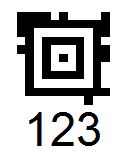Aztec Rune

Aztec Rune is a variant of Aztec Code that is designed to be graphically compatible with Aztec Code. It consists of the core symbol of the compact version of Aztec Code together with a numerically distinct data message that conveys 8 bits of data. Aztec Rune contains 256 11 x 11 module square marks that can be scanned by any Aztec Code reader. Printing white on black is an option.
Aztec Rune is defined in Annex A of ISO/IEC 24778 Information technology - Automatic identification and data capture techniques - Aztec Code bar code symbology specification.
The symbol comprises the following elements:
-
Finder pattern: A square bull's-eye structure in the center that consists of four alternating black and white square rings that are one module wide and a center square that is one module wide and high. (This square is black unless the white-on-black option is being used).
-
Orientation patterns: The layer outside the outermost ring of the finder pattern is a one-module-wide layer that contains chevron-shaped orientation patterns in each corner. These patterns consist of three one-module squares. The first pattern, at the upper left corner, consists of three black modules. The second pattern, at the upper right, is one white module followed by two black modules. The third, at the lower right, is one black module followed by two white modules. The fourth, at the lower left, is three white modules.
-
Data message:The remainder of the barcode consists of one data layer that contains data and Reed-Solomon check characters. This layer is read in a clockwise direction. The character encodation method is the same as for the compact version of Aztec Code.
Because Aztec Runes are read from the inside out, no quiet zone is required.
This symbology supports all 255 ASCII characters (digits 0-9, text, and binary data).
Aztec Rune uses the Reed-Solomon algorithm for error correction in the same manner as the compact version of Aztec Code.

